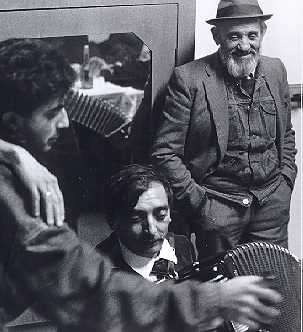1. The identity of a Gypsy community
The Gypsies are the descendants of populations
originating in Northern India (see Fraser 1992, and De Vaux De
Foletier 1990: 37-40) who, around the 1000 AD, were forced out by
an expanding Islam, and, possibly, periods of famine (see Colocci
1889: 9-32, and Puxon 1979: 6-11). The Romani, which is
the language spoken by most Gypsies in countless local dialects,
is an Indic language that was modified by external influences of
various provenance. Indeed, these influences indicate the paths
they followed in their emigration to the West. In some regions of
Northern India, especially in Rajasthan, there are still
blacksmiths, players, dancers, jugglers, animal trainers,
ambulants, beggars of low rank, whose names (such as Lohar,
Kanjar, Beria) and occupations are to be found amongst
Gypsy groups in Europe. During the emigration to the West, some
groups settled in Persia, Turkey, and Greece (see De Vaux De
Foletier 1990: 41-45), whereas others spread across the Slavic
regions and settled in several areas of Western Europe, such as
Italy, Spain, France, Germany, Austria, Holland, Belgium, Sweden
and Finland (see De Vaux De Foletier 1990: 46-65).
The Gitanos, or Cales, living in
Andalusia, in Northern Spain and in Southern France; the Manouches,
or Sinti, living in France, Germany, Austria, as well as
in the Italian regions of Piedmont, Veneto, and Emilia; the Cales,
living in Northern Europe; the Roma of ex-Yugoslavia; the Roma
and Sinti from Slovakia, Hungary, Bulgaria, Romania, and
Greece; and the Roma of Southern Italy (see Karpati 1994)
all have cultural horizons, mythological and religious systems,
daily habits and dialects that are quite different from one
another.
Some are nomads or have been so until the
relatively recent past; others are ambulants (2), whilst others are sedentary. All these groups have
selectively absorbed the cultural habits of the populations of
the area where they have settled or in which they have travelled.
The only substantial difference between the Roma and the
neighbouring populations lies, it would appear, in the language:
the majority of the Gypsy groups know and make use of variants of
Romani, even though they also speak the local languages, and in
some cases these have completely replaced Romani.
Even the names that distinguish the various
Gypsy groups bear witness to their proximity to a culture that is
nonetheless different from their own. There is a certain
confusion about the ethnonyms (either self-attributed or imposed
from the outside) applied to Gypsy groups (see Salo 1979 and
Li�geois 1994: 29-31). It is difficult to label each group in a
simple and straightforward way: the various groups identify
themselves or may be identified by others (i.e., by other Gypsy
groups, or by the non-Gypsy populations who live on the same
territory) by using names which overlap, or may mix, and, above
all, follow non-homogeneous classificatory patterns (see De Vaux
De Foletier 1990: 19-24). Roma, the general term with
which many Gypsy groups define themselves in their totality
(especially in the Balkans) is the plural of Rom
("man"), and simply means "people". Manouche,
the self-denomination of the French Sinti groups, means
"person". Cal� (or Cales), the
self-denomination of both the Andalusian Gitans and Northern
European groups, means "black" — thus takes origin
from a pigment of the skin darker than the local populations. The
denominations of some Balcanic groups, such as Kalderashi,
Ursari, and Lautari, refer to the prevalent
occupation within each group (such as coppersmiths,
bear-trainers, and musicians). Cergashi (orCergari)
refers to groups of nomads who come for the most part from
the ex-Yugoslavia. The term means "those of the tents,"
in opposition to permanent groups. The terms Harvati, Slovenska,
Shiptari are used in Croat, Slovenian, and Albanian
languages to indicate the place of provenance of, respectively,
Croat, Slovenian, and Albanian groups. Obviously, these are names
that were attributed to them by Gypsy groups coming from other
areas, since they do not distinguish the Roma from the Croat,
Slovenian, and Albanian populations who live in the same
territory. For example, the Albanian Roma are called Shiptari
by the Roma Harvati, or even by the Cergari; for
the Albanians, they are simply Gabrd�n (i.e., 'Gypsies'),
and call themselves simply Roma, or even Roma Khorakhan�,
meaning 'Muslim Roma'. Each group, then, may know a variety of
names that are either imposed from the outside, or self-given;
each of these names emphasises a different element of distinction
from the other groups: area of provenance, activity, religion,
nomadic life-style, and so forth. Every ethnonym, therefore,
circumscribes a whole that intersects with others.
 Music
for St. Nicolaus Day at the Dassikhan� camp, Sasso
Marconi, Bologna
Photo N. Staiti
|
Names distinguishing
Christian-Orthodox and Muslim Gypsies in the former
Yugoslavia clearly show the close proximity of these two
distinct Gypsy groups to the surrounding dominant
culture. At the same time, however, these names also
point to what it is that distinguishes these groups from
one another. 'Dasikhan�'
(the name for the Christian-Orthodox) means 'in the
fashion of the Serbs', whereas 'Khorakhan�' (the
name for the Muslims), means 'in the way of the Koran',
i.e. of Islam. Thus, religious affiliation is such an
important element that it is taken as a distinctive
feature (3).
But it is important to stress that these terms do not
simply mean 'Muslim' or 'Christian', but rather 'in the
fashion' of Muslims and Christian Serbs. Indeed,
Christian Roma of Macedonia, Kosovo, Montenegro are
commonly distinguished from Muslims by the term Gajekhan�,
meaning 'in the way of the gaje', i.e., of those
who are not Roma, thus emphasising the fact that these
groups are supposedly or actually more integrated in the
wider society.
|
It should be clear that the differences between
the nuptial rites and the music of the Khorakhan�
Shiptari and those of the Dasikhan� are important, along
with the more general cultural differences between the two
groups. The rites of these two groups are virtually identical to
those of the non-Roma people who live in the same territory: the
Albanians from the Kosovo and Montenegro regions, who live
alongside the Khorakhan�, and the Serbs, who host several
communities of Dasikhan�. Music and dance for both Khorakhan�
and Dasikhan�(at least the music performed by
professional orchestras at feasts; the domestic situation is
quite different), are closely connected to those of their
non-Roma neighbours. The musicians are predominantly Roma, since
professional and semi-professional musical activities are
widespread among both the Dasikhan� and the Khorakhan�.
They lend their skills indifferently to both Roma and Gaje.
Thus, the music and the nuptial rites of the Khorakhan�
are virtually identical to those of the non-Roma Albanians, and
the same is true for the Dasikhan� and the local Serbs.
As I will show below, the difference between the Roma rituals and
those of the agrarian-pastoral communities who live in the same
area lies in the way in which they are performed and interpreted,
rather than in their structure.
The Roma share their religious practices,
relationships and judicial systems, traditional costumes,
everyday food and rituals, family and social rites, music and
dances with these agrarian-pastoral communities. The texts of the
songs, even those for ceremonies within the Roma community, are
mostly in either Albanian or Serbian, not in Romani. They are,
however, extremely conscious of their 'Gypsyness' (4) and are careful to emphasise the difference - however
subtle and vague it may be - between themselves and others. At
the same time, the Khorakhan� Shiptari are strongly aware
of the difference between themselves and the other Roma groups,
or, in the case of Italy, between themselves and the Sinti: each
one of these is, for the others, a 'Gypsy', i.e., a savage (5). However, despite the fact that the differences between
various Roma groups are visibly and forcefully stressed, and
although some are always 'Gypsies' to the others, the awareness
of a supranational Gypsy identity (other than Roma) is also very
strong: Slavonic Khorakhan� and Dasikhan�, but
also French Manouches, Spanish Gitani, Italian Sinti,
and even the nomads of Rajastan feel an affinity and believe that
they share a common culture despite enormous cultural distances.
The strength and the depth of this sense of belonging to an
overarching cultural unity make it difficult to consider it as a
recent development.
The Roma Khorakhan� Shiptari,
then, like most Gypsies, display a strong sense of distinct
social identity but share the cultural horizons of the wider
community to which they belong. This group distinguishes itself
from the rest of the community through the use of Romani (which
exists alongside, but does not substitute the local language),
and also in part through their professional activities, as well
as what could be defined as a way of interpreting local
traditions. Indeed, the Roma Khorakhan� Shiptari
play a particular role in the varied and layered society to which
they belong. Gypsies are normally (or have until recently been)
horse breeders and traders, blacksmiths (then metal junk
collectors and automobile-wreckers), beggars, musicians, dancers,
jugglers, horse trainers, circus people, and itinerant side-show
workers.

Khorakhan�
girl at the luna-park, Palermo
- Photo N. Staiti
They define themselves primarily through what
makes them different from the other social groups (6). Perhaps they might best be described as
'non-peasants', that is to say, not tied to the land and
landlord, seasons, and a sedentary life. Their different ethnic
origins are no doubt historically relevant for the purposes of
determining the role that the Gypsies actually play within the
larger society in which they live and interact. However, the
ethnic element seems to be only one of a number of components of
their identity, as far as it is perceived by themselves and by
other groups (7).
The Khorakhan� Shiptari,
although consisting mainly of non-nomads, have traditionally also
carried out activities of an itinerant nature. This fact
explains, moreover, why the exodus towards the west by Serbian,
Bosnian and Albanian populations as a result of the war in the
former Yugoslavia affected primarily the Roma people, and did so
with an intensity that reminds us of the expulsion of the
'Gypsies' of North-India by an expanding Islam in the Middle
ages, an expulsion that, even then, was to scatter them westward.
These 'non-peasants' have acquired a specialisation as
professional or semi-professional interpreters of local
traditions. In short, one could paradoxically say that today the
Roma Khorakhan�, as far as traditions go, are more
Albanian than the Albanians, and it is just here that their
specific character lies. They do not possess music or dances that
distinguish them categorically from others, but as a general rule
the best Albanian musicians and dancers are Roma. They read the
coffee residues like the Albanians, but the most clever
interpreters, as well as the great 'shamans' (8), are almost always Roma. Moreover, the community is not
protected by a rigid endogamy, but by a rigorous patrilineal and
patrilocal system. The son assumes the social identity and the
cultural inheritance of the father's family, with whom he remains
in case of separation or death of one of the parents, whether he
be a Roma or an Albanian gaje. The wife too assumes the
identity of the husband: she becomes a Romn� (i. e. a
Roma woman) if she marries a Rom (a Roma man), and an
Albanian if she marries an Albanian. It is therefore the women,
in a special way, who become the intermediaries of tradition
between the various groups. The differences, therefore, are not
perceived as racial, as much as a matter of social roles and
cultural specialisation (see interview and comments in note
9).
Forward | Rom main page | References

